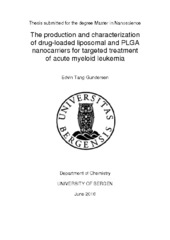| dc.description.abstract | While some progress has been made lately in developing transplantation therapy against acute myeloid leukemia (AML), it remains a problematic and aggressive disease, associated with both poor survival, as well as treatments with high toxicity. The field of nanomedicine is however aiming to improve treatment therapies by using dedicated nanocarriers to deliver therapeutics. Such drug delivery systems may provide benefits like more targeted drug delivery, as well as reduced side effects. Nanocarriers also open up for the repurposing of old drugs for new targets, as well as tools to deliver drug with poor pharmacokinetic properties. This project dealt with the production, characterization, and in vitro experimentation of liposomal and PLGA-based nanocarriers, with the aim of determining whether or not they were suitable to carry drugs directed against AML cells. The present study investigated the size and morphology of nanoparticles, ability to carry drugs, internalization into AML cells, and cytotoxic properties. In addition, the possibility to deliver siRNA into AML cells was explored. Liposomes and polymeric PLGA nanoparticles were studied as drug delivery systems. Both DLS and TEM characterization showed favorable results for both liposomes and PLGA nanoparticles, both being under 400 nm and thus viable for traveling through the blood stream. Internalization of nanocarriers into AML cells was also successfully demonstrated. AML cells had a high endocytic capacity for liposomes and PLGA nanoparticles. Liposome internalization could not be dampened by inhibitors of clathrin- or caveolin-mediated endocytosis. Drug loading experiments showed that PLGA had acceptable capacity to carry chlorpromazine, with a limited release of the drug during 72 hours. A peptide based drug was sought loaded into liposomes, but with a very limited encapsulation efficiency. The success in drug loading was also evident in the cytotoxicity experiments, where CPZ-loaded PLGA nanoparticles demonstrated to have a clear apoptotic effect on AML cells equivalent to that of free drug, while no conclusive data was obtained from liposomal delivery of NATinhibitor peptide. Attempts were made at using liposomes for more advanced targeting 2 therapy with siRNA and RNAi-based therapy, and though some potential was seen, no effect from siRNA was demonstrated when used with produced cationic liposomes. The data in this study demonstrates that nano- based drug delivery systems have potential for anti-AML therapy, and can accelerate the development of novel therapies, both using new drugs candidates, and the repurposing of old" drugs. | en_US |
